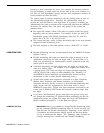
HOW TO USE
To monitor and change ESS status from an attendant console:
1 Check the green light next to the voice terminal’s Auto Intercom button.
Green light off
=
voice terminal is not in either ESS state.
Green light flashing
=
voice terminal is in ESS1 state
Green light steady
=
voice terminal is in ESS2 state
2 If you have buttons programmed to put voice terminals in ESS1, ESS2 and
standard call-handling states, touch the appropriate button. Otherwise,
dial the appropriate code, as follows:
To remove a voice terminal from either ESS state, dial #35.
To put a voice terminal in the ESS1 state, dial #36.
To put a voice terminal in the ESS2 state, dial #37.
3 Touch the Auto Intercom button for the voice terminal whose status you
want to change.
To change an ESS state at a voice terminal or telephone:
For ATL/DCP sets:
1 Touch the appropriate button, ESS1 or ESS2.
For Basic Touch-Tone sets:
1 Dial #01 to put the telephone in ESS1 state; #02 to put it in ESS2 state,
or notify the attendant to change the ESS state.
Flexible Numbering
DESCRIPTION
Default dialing codes are used during the initial administration of stations,
lines, line pools, and the Call Distribution and Group Page features. The
administrator can use the Flexible Numbering feature to change these default
dialing codes.
The default dialing codes are as follows:
Stations - Intercom numbers 10 through 69 and 700 through 727.
(A system can have only 72 responding stations. However, some
voice terminals may have two intercom numbers associated with them
because of the Voice Announcement to Busy Voice Terminal feature.)
Lines - Line codes 801 through 856.
Line pools -9 and 890 through 899.
Call Distribution groups -870 through 875.
Group Page groups -881 through 887.
The Flexible Numbering feature lets administrators change these codes to
other l-digit to 4-digit numbers that are more meaningful for their particular
MERLIN II System Features
2-63


















